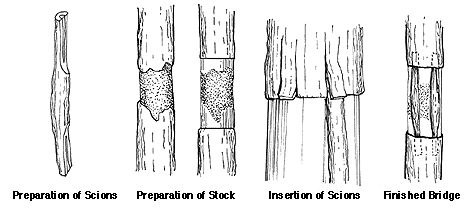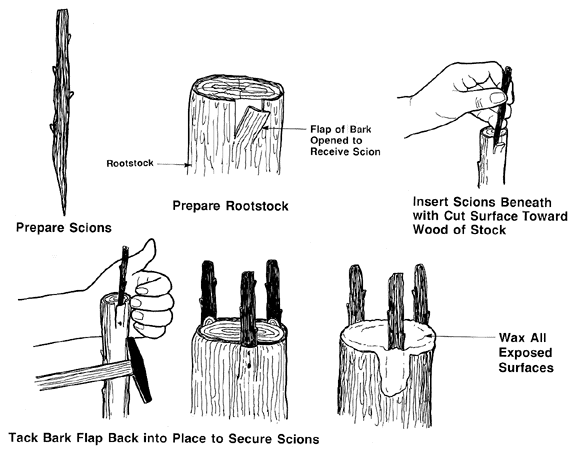Bridge
grafting is used to "bridge" a diseased
or damaged area of a
plant, usually at or near the base of the trunk. Such damage commonly
results from contact with grading or lawn maintenance equipment, or it
may be caused by rodents, cold temperatures, or disease organisms. The
bridge graft provides support as well as a pipeline that allows water
and nutrients to move across the damaged area.
Bridge grafts are
usually done in early spring just before active plant growth begins.
They may be performed any time the bark on the injured plant "slips."
Preparing the Scion
Select scions
that are straight and about
twice as long as the damaged area to be bridged. Make a 1½-
to
2-inch-long tapered cut on the same plane at each end of the scion.
Preparing the Stock
Remove any
damaged tissue so the graft is on
healthy stems. Cut a flap in the bark on the rootstock the same width
as the scion and below the injury to be repaired. Gently fold the flap
away from the stock, being careful not to tear the bark flap.
Inserting the Scion
First, insert
and secure the scion below the
injury; push the scion under the flap with the cut portion of the scion
against the wood of the injured stem or trunk. Then go back and insert
and secure the scion above the injury following these same steps. Push
the scion firmly into place. Pull the flap over the scion and tack it
into place as described for bark grafting (Figure 2).
When
grafting with young stems that may waver in the wind, insert the scions
so that they bow outward slightly. Bridge grafts should be spaced about
3 to 4 inches apart across the damaged area.
Securing the
Graft
Secure all
graft areas with warm grafting wax or grafting paint.
During and after the healing period, remove any buds or shoots that
develop on the scions.

